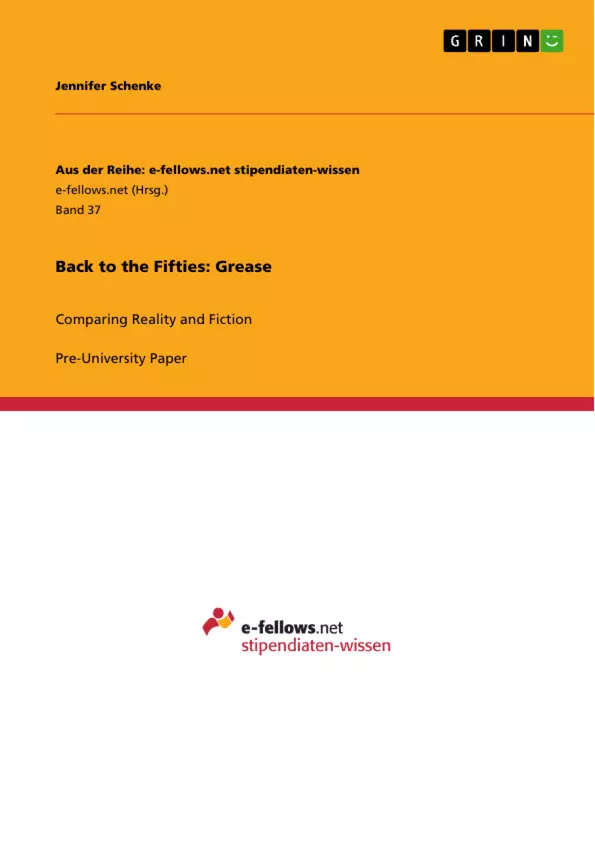Grease, highly successful in the 70s as both a musical and a movie, is sometimes criticized as being too nostalgic and unauthentic by only showing an idealized version of the 50s.
The audience of the 70s, which the movie appealed to, was too young to compare the 50s portrayed in the movie with reality, critics say.3
In this paper, I would like to discuss aspects of the movie and compare them with the reality of the 50s. It is important to see beyond the prevalent plot of the movie, the love story between Danny and Sandy, and to concentrate in more detail on supporting roles and
the overall atmosphere. Of course, Grease would not be Grease without its music. The 50s do not only mark the birth of a new style of music, Rock and Roll, but also of a new culture, that of teenagers, a fact which is clearly reflected in Grease. Thus, I will first look at Rock and Roll, and its effects on the development of a youth culture, and then point out a few problems these changes brought with them.
Inhaltsverzeichnis (Table of Contents)
- Preface
- Introduction
- The music of Grease - Rock and Roll
- Historical background & beginning
- Role models for the music in Grease
- Rock and Roll as a lifestyle - Clothes of the 50s
- New problems - new values
- Rebellious versus preppy
- Teenage pregnancy
- Dropouts and teenage unemployment
- Conclusion
- Sources
- Appendix
Zielsetzung und Themenschwerpunkte (Objectives and Key Themes)
This paper aims to analyze the movie Grease and its portrayal of the 1950s, comparing the film's depictions with historical realities. The focus will extend beyond the central love story to explore supporting roles and the overall atmosphere, while also examining the impact of Rock and Roll on the development of youth culture.
- The influence of 1950s Rock and Roll music on the movie Grease
- The emergence of teenage culture in the 1950s and its reflection in Grease
- The social problems that arose alongside the development of youth culture, such as rebellious youth, teenage pregnancy, and unemployment
- The movie's portrayal of 1950s life, including social norms, fashion, and attitudes
- The differences and similarities between the idealized version of the 1950s presented in the movie and the historical reality
Zusammenfassung der Kapitel (Chapter Summaries)
- Preface: Provides a brief overview of the movie Grease, its origin as a musical, and its enduring popularity. It also introduces the central characters, Danny and Sandy, and hints at the movie's central conflict.
- Introduction: The author expresses their personal connection to the movie and its music. They discuss the widespread appeal of Grease and its potential for romanticized nostalgia. The introduction also outlines the paper's objective to compare the movie's depiction of the 1950s with historical reality.
- The music of Grease - Rock and Roll: This chapter examines the importance of music in both the musical and the movie. It highlights the presence of original 1950s Rock and Roll songs and the contribution of the Sha-Na-Na band. It then delves into the historical background of Rock and Roll, its origins in rhythm and blues, and its appeal to teenagers.
- Historical background & beginning: The author explores the roots of Rock and Roll, tracing its development from African American rhythm and blues to its eventual mainstream acceptance. They discuss the themes and characteristics that made Rock and Roll particularly relevant to young people.
Schlüsselwörter (Keywords)
The paper focuses on the movie Grease, 1950s American culture, Rock and Roll music, youth culture, teenage rebellion, social problems, teenage pregnancy, teenage unemployment, historical accuracy, and idealized representations.
- Arbeit zitieren
- Jennifer Schenke (Autor:in), 2008, Back to the Fifties: Grease, München, GRIN Verlag, https://www.grin.com/document/174173



